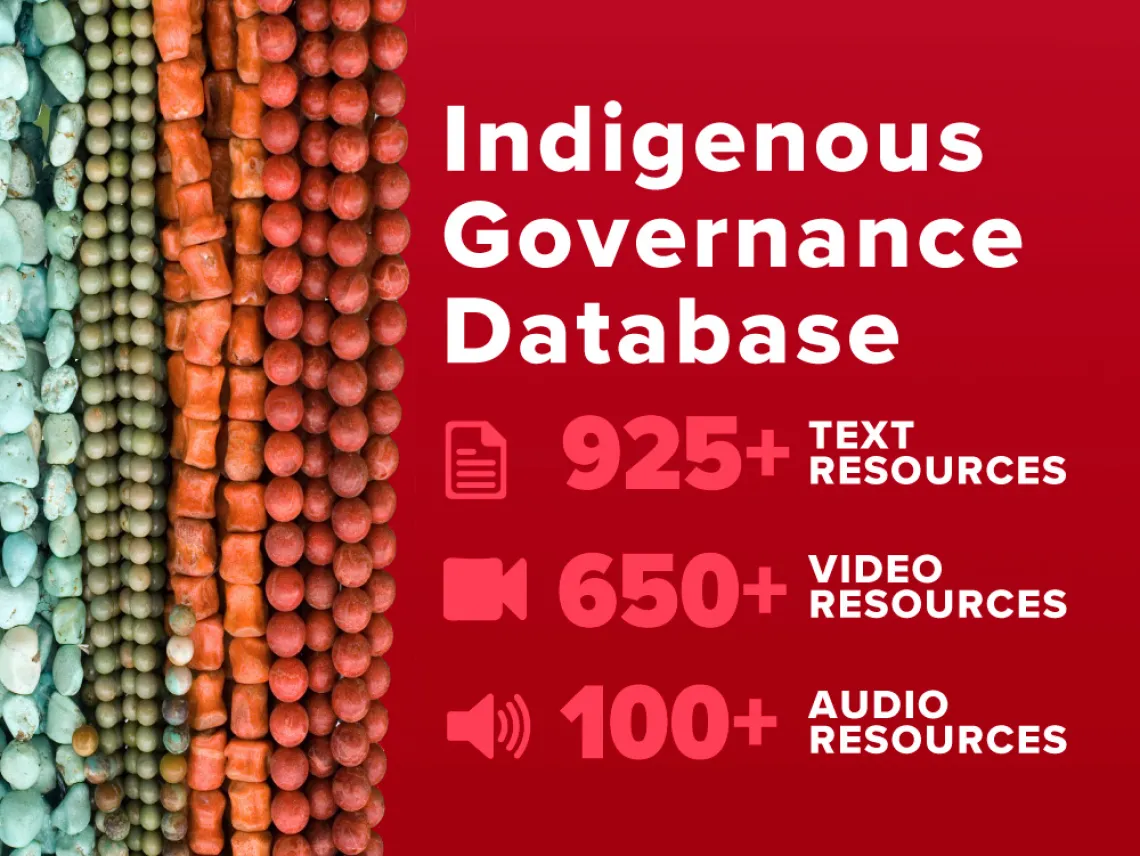NNI’s Indigenous Governance Database Breaks 500k-View Threshold
The interactive, customizable database offers users the ability to build their own personal resource libraries from more than 1600 resources on Native nation building and Indigenous governance.

Just two months before its 11th anniversary, the Native Nations Institute’s (NNI) Indigenous Governance Database (IGD) hit a major milestone in August when it surpassed half-a-million resource views over the life of the platform.
Launched in September 2012 and updated for performance and functionality in 2017 and 2022, the IGD is a free library of digital resources including videos, audio recordings and documents chronicling the best-of-the-best when it comes to instructional and educational content related to Native nation building, tribal governance, constitutional reform and more.
Amy Jorgensen is NNI’s Senior Graphic Designer and Program Coordinator. Part of her role involves serving as the Institute’s Digital Resource Manager, including managing the IGD. “It’s really exciting to see the database growing organically and to know that it’s playing a part in helping Indigenous leaders find proven ways to make changes in support of their ability to self-govern,” says Jorgensen.
Jorgensen, who has been with NNI since 2015, says there has never been any formal advertising done for the IGD, meaning that all of its current users found their way to the database on their own or by word of mouth.
A Hub for Collaborative Research

NNI created this custom video library to share on Indigenous Peoples' Day 2023.
Today, the IGD includes more than 1600 resources on 16 key topics ranging from Citizenship, to Environmental Resources, to Land/Jurisdiction and Indigenous Laws and Codes. All of the resources in the IGD are available to access for free.
Visitors to the database can search for resources using keywords, look for content from specific thought leaders, filter by content type and even search for resources by or about specific Native nations.
The platform also offers users the ability to create a unique login which enables them to build their own research libraries highlighting specific resources and/or topics that resonate most with their nation-building interests. Once built, those personal libraries can also be shared with friends, peers and colleagues.
According to Jorgensen, this feature makes the IGD much more than a digital library. “The personal library feature of the database adds an interactive element to the site that makes it valuable for a variety of uses outside of just searching for information,” says Jorgensen.
Jorgensen points out that the personal library feature can work as a tool to aggregate materials for myriad collaborative research efforts and use cases. It’s also a great resource for students in need of scholarly research materials on Indigenous governance and for educators looking for supplemental multimedia content for lectures, lessons and assignments.
Though many students have utilized the IGD library-building function over the years, the bulk of account holders are professionals working in leadership and educational roles such as elected officials, policy specialists, legislators, librarians, media professionals, lawyers, judges, professors, researchers and more.
“It's like Google for Indigenous leaders”
In the 10-plus years it’s existed, the IGD has seen steady growth in its collection and user base, which has required improvements to it's search function, adding more value to the site. Here are a few numbers that put the value of this resource into perspective:
- > 507,000 resources viewed
- > 2700 unique accounts created
- ~ 4500 resources accessed per month
- ~ 2000 unique visitors per month
- 1686 individual Indigenous governance resources, including
- 932 text-based documents
- 656 videos
- 98 audio files
NNI continues to add content to the IGD on a regular basis and welcomes resource referrals and recommendations from the public and users of the database.
“We’re always looking to add to the IGD,” says Jorgensen. “In fact,” she adds, “one of the most valuable and interesting things about this database is that it’s always growing and changing to reflect the issues impacting Indian Country today.”
Jorgensen says that she and her NNI colleagues are excited to see the IGD hit that milestone of half-a-million views, but that there’s no intention at the Institute to pull back on their support for this important and valuable public resource. In fact, the NNI team is currently holding conversations to uncover ways to improve the IGD and get it in front of a larger user base.
“It's like Google specifically for Indigenous leaders and those interested in learning Native nation-building skills,” Jorgensen says. “We’re just getting warmed up and we’ll continue to add resources and features to the IGD as long as people are finding value there.”
And, given the sheer volume of that database, its consistent growth and the unique content available inside, it’s likely that the value of the IGD will continue to increase during its second decade.
Explore the Indigenous Governance Database for yourself here

